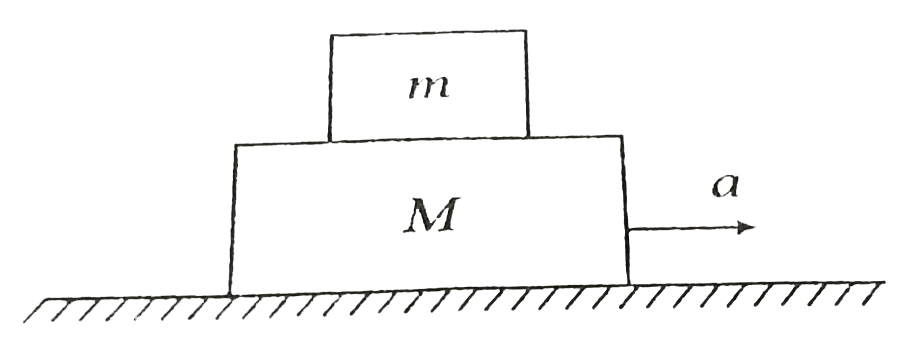A body of mass m is placed on a platform of mass M ( m<M), moving with a velocity v. If the coefficient of friction between the platform and the mass is μ then for how long will the body continue to slide on the platform and what distance will it cover during that time?
When the platform moves the body on it tends to slide backwards. So the frictional force on the body acts in the direction of motion of the platform. It is given by , f = μmg.
∴ Its acceleration a = fm=μg
When the velocity of the body becomes v it no longer slides over the platform.
We know v = u+at or,t=v+ua
Here u=0, a = μg∴t=vμg
Again v2=u2+2as or,s=v2−u22a=v22μg
∴ The body will slide for a time of vμg, and in this interval of time it will cover a distance of v22μg.
Topper's Solved these Questions
- FRICTION BOOK - CHHAYA PUBLICATIONCHAPTER - FRICTION EXERCISE - EXERCISE (Multiple Choice Questions )
10 Videos
- FRICTION BOOK - CHHAYA PUBLICATIONCHAPTER - FRICTION EXERCISE - EXERCISE (Based on Motion on inclined Surface )
7 Videos
- FRICTION BOOK - CHHAYA PUBLICATIONCHAPTER - FRICTION EXERCISE - Section Related Questions
9 Videos
- FIRST AND SECOND LAW OF THERMODYNAMICSBOOK - CHHAYA PUBLICATIONCHAPTER - FIRST AND SECOND LAW OF THERMODYNAMICSEXERCISE - CBSE SCANNER
18 Videos
- HYDROSTATICSBOOK - CHHAYA PUBLICATIONCHAPTER - HYDROSTATICSEXERCISE - CBSE SCANNER
1 Videos
Similar Questions
Knowledge Check
A block of mass m is placed gently onto a long plank of mass M moving with a velocity v0 on a smooth horizontal floor. If friction is present between M and m :
 Avcentre of mass=Mv0M+mBWfriction on m is positiveCWFriction on M is negativeDfinal velocity of both =mv0m+M
Avcentre of mass=Mv0M+mBWfriction on m is positiveCWFriction on M is negativeDfinal velocity of both =mv0m+MA body of mass m kept on the floor of a lift moving downwards is pulled horizontally. If μ is the coefficient of friction between the surface in contact, then
Africtional resistance offered by the floor is 2 μmg, when lift moves up with a uniform velocity of 5 m/s.Brictional resistance offered by the floor is μumg, when lift moves lift moves up with uniform velocity of 3 m/s.Cfrictional resistance offered by the floor is 4.8μmg, when lift accelerates down with an acceleration of 4.8m/s2Dfrictional resistance offered by the floor must lie in the range 0≤f<∞If μ is the coefficient of friction between the tyres and road then the least stopping distance for a car of mass m moving with velocity v is
Av2/2μgBv/2μgC2v/μ2gD2v/μg
A body of mass m slides down a rough plane of inclination α . If μ is the coefficient of friction, then acceleration of the body will be
View SolutionA block of mass m is placed on the top of another block of mass M as shown in the figure. The coefficient of friction between them is μ.

The maximum acceleration with which the block M may move so that m also moves along with it is
View SolutionA man of mass m is standing on a platform of mass M kept on smooth ice. If the man starts moving on the platform with a speed v relative to the platform with what velocity relative to the ice does the platform recoil?
View SolutionA body of mass m slides down a rough plane of inclination α . If μ is the coefficient of friction, then acceleration of the body will be
View SolutionA block of mass m is placed on the top of another block of mass M as shown in the figure. The coefficient of friction between them is μ.

The maximum acceleration with which the block M may move so that m also moves along with it is
View Solution

